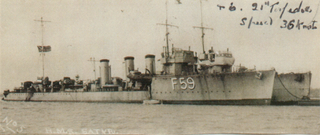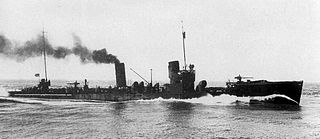SMS V45 was a 1913 Type large torpedo boat of the Imperial German Navy during World War I. V45 was built by AG Vulcan at their Stettin shipyard, being launched on 29 March 1915 and completed on 30 September that year.

HMS Torrent was a Royal Navy R-class destroyer constructed and then operational in the First World War. She was sunk, with most of her crew in 1917. On 23 December 1917 Surprise, HMS Torrent, and Tornado sank after entering an Imperial German minefield.

HMS Surprise was a Royal Navy R-class destroyer constructed and then operational in the First World War. She was sunk, with most of her crew in 1917. On 23 December 1917 HMS Surprise, Torrent, and Tornado sank after entering an Imperial German minefield.

HMS Nimrod was a Marksman-class flotilla leader of the British Royal Navy. She was built by the Scottish shipbuilder Denny, with construction starting in 1914 and completed in August 1915. She served through the remainder of the First World War. She was sold for scrap in 1921.
HMS Lightfoot was a Marksman-class flotilla leader of the British Royal Navy. Construction by J. Samuel White began in June 1914, shortly before the outbreak of the First World War, and the ship was launched and completed in 1915. She survived the war and was sold for scrap in 1921.

SMS V47 was a V25-class Large Torpedo Boat of the Imperial German Navy that was built and served during the First World War.

HMS Sharpshooter was an R-class destroyer which served with the Royal Navy during World War I. Launched on 27 February 1917, the ship joined the Harwich Force, undertaking convoy escort duties. The vessel also took part in the Navy’s bombardment of Ostend later that year. On 1 June 1918, the destroyer rescued Captain A. C. Sharwood, one of the first pilots of the Royal Australian Navy, who ditched his Sopwith 2F.1 Camel nearby. After the war, Sharpshooter joined the Navy gunnery training establishment at Plymouth, but did not stay long and was reduced to Reduced Complement on 5 March 1919. The Royal Navy was rationalising its destroyer force and Sharpshooter, deemed superfluous, was sold to be broken up on 29 April 1927.

HMS Matchless was a Royal Navy Admiralty M-class destroyer. Matchless was built by Swan Hunter from 1913 to 1914 and was completed in December that year. She served through the remainder of the First World War, operating in the North Sea as part of the Harwich Force in the early part of the war and later in the English Channel as part of the Dover Patrol, where she took part in both the First and Second Ostend Raids. Despite being badly damaged by a German mine in 1915 and being involved in several collisions, she survived the war, and was sold for scrap in 1921.
SMS V44 was a V25-class Large Torpedo Boat of the Imperial German Navy, that served during the First World War. V44 was built by AG Vulcan at their Stettin shipyard from 1914–1915, entering service on 22 July that year. V44 took part in the Battle of Jutland in 1916, and also operated in the English Channel and the Baltic. She survived the war, and was interned at Scapa Flow, surviving the Scuttling of the German fleet at Scapa Flow. She was used as a target by the British at Portsmouth, and later scrapped in-situ in 1922, although remnants of the ship remain in Portsmouth Harbour.

SMS V43 was a V25-class Large Torpedo Boat of the Imperial German Navy, that served during the First World War. V43 was built by AG Vulcan at their Stettin shipyard from 1914–1915, entering service on 28 May that year. V43 took part in operations in the North Sea, the English Channel and the Baltic Sea. She survived the war, and was interned at Scapa Flow, surviving the Scuttling of the German fleet at Scapa Flow. V43 was allocated to the US Navy, and was sunk as a target on 15 July 1921.
SMS V26 was a V25-class torpedo boat of the Imperial German Navy that served during the First World War. The ship was built by AG Vulcan at Stettin in Prussia, and was completed in June 1914.
HMS Grenville was a Parker-class flotilla leader of the British Royal Navy. She was built by Cammell Laird during the First World War, being launched on 17 June 1916 and completing on 11 October that year. Grenville served with the Grand Fleet for the rest of the war, which she survived. The ship took part in operations in the Baltic during the Russian Civil War in the winter of 1919–1920, before entering a long period of reserve. She was sold for scrap in December 1931.
HMS Melpomene was a Medea-class destroyer of the British Royal Navy. She was one of four destroyers, of similar design to the British M-class ordered by Greece in June 1914, which the British purchased during construction owing to the outbreak of the First World War.

HMS Laurel was a Laforey-class destroyer which served with the Royal Navy. Launched on 6 May 1913 as HMS Redgauntlet, the ship was renamed on 30 September under an Admiralty order to become one of the first alphabetical class destroyers. On commissioning, the vessel joined the 3rd Destroyer Flotilla and operated as part of the Harwich Force during the First World War. During Battle of Heligoland Bight, Laurel led a flotilla that pursued German torpedo boats, engaging with G194 and G196, and was damaged in action with the cruiser Mainz. The vessel also played a minor role in the Battles of Dogger Bank, Dover Strait and Jutland. With the cessation of hostilities, the ship was placed in reserve and scrapped on 1 November 1921.

HMS Liberty was a Laforey-class destroyer that served with the Royal Navy during the First World War. Launched on 15 September 1913 as HMS Rosalind, the ship was renamed on 30 September under an Admiralty order to become one of the first alphabetical class destroyers. On commissioning, the vessel joined the Third Destroyer Flotilla and operated as part of the Harwich Force. During Battle of Heligoland Bight, Liberty engaged with the German torpedo boats G194 and G196, and scored two hits on the cruiser Mainz. On 8 February 1917, the destroyer rammed and sank the German submarine UC-46. The vessel also played a minor role in the battles of Dogger Bank, Dover Strait and Jutland, as well as acting as a convoy escort and patrolling the Dover Barrage. With the cessation of hostilities, the ship was placed in reserve and sold to be broken up on 5 November 1921.
SMS V28 was a V25-class torpedo boat of the Imperial German Navy that served during the First World War. The ship was built by AG Vulcan at Stettin in Prussia, and was completed in September 1914. The ship took part in the Battle of Dogger Bank, the Battle of the Gulf of Riga in 1915, and the Battle of Jutland on 31 May 1916.
SMS V30 was a V25-class torpedo boat of the Imperial German Navy that served during the First World War. The ship was built by AG Vulcan at Stettin in Prussia, and was completed in November 1914.
SMS S15 was a V1-class torpedo boat of the Imperial German Navy. The ship was built by Schichau-Werke, at their Elbing shipyard, completing in 1912.

HMS Sylph was an R-class destroyer that served in the Royal Navy during the First World War. The R class were an improvement on the previous M class with geared steam turbines to improve efficiency. Launched by Harland & Wolff at Govan on 10 February 1917, Sylph joined the Harwich Force and escorted merchant ships and convoys in the North Sea. The ship encountered both German submarines and torpedo boats but did not record any hits on the enemy. However, during one action in foggy weather, the destroyer struck and sank sister ship Setter. After the Armistice that ended the war, the destroyer was initially placed in the reserve before being transferred to the Torpedo School in 1919. On 16 December 1926, Sylph was sold to be broken up.

HMS Stork was an R-class destroyer that served in the Royal Navy during the First World War. The R-class were an improvement on the previous M-class with geared steam turbines to improve efficiency. Launched by Hawthorn Leslie at Hebburn in 1917, Stork joined the Harwich Force. The destroyer saw service escorting convoys in the English Channel and encountered both German submarines and torpedo boats, but did not record any hits on the enemy. The vessel also supported attacks on German forces on the coast of Western Europe by Coastal Motor Boats, flying boats and monitors, including the Zeebrugge Raid of 1918.









